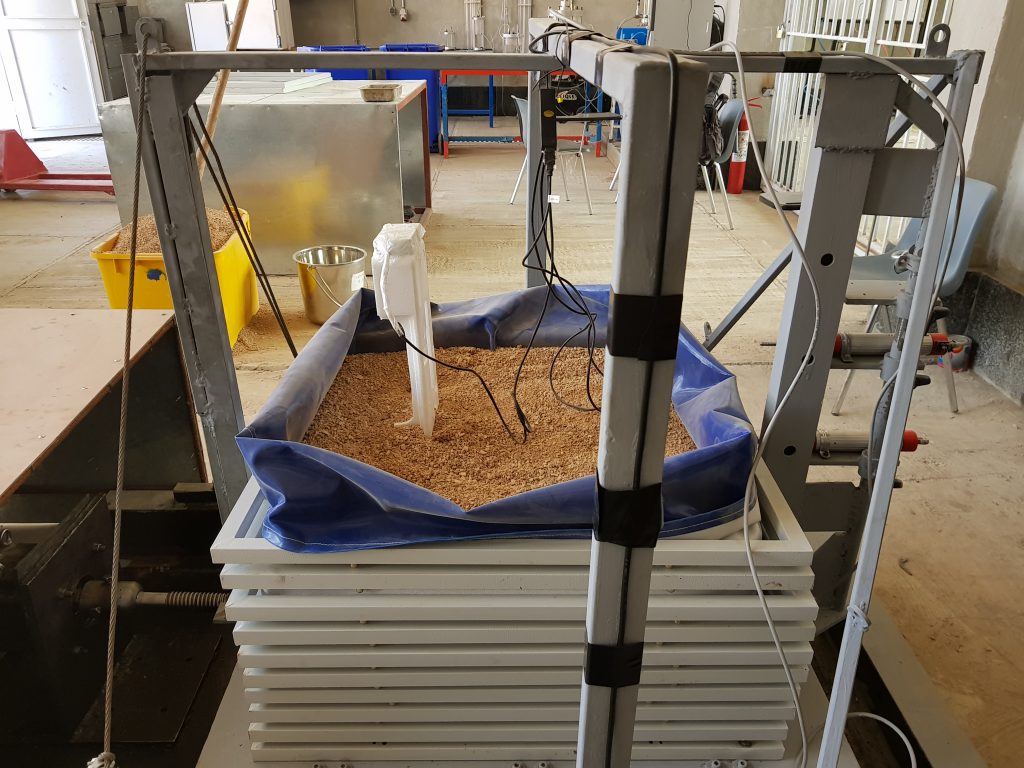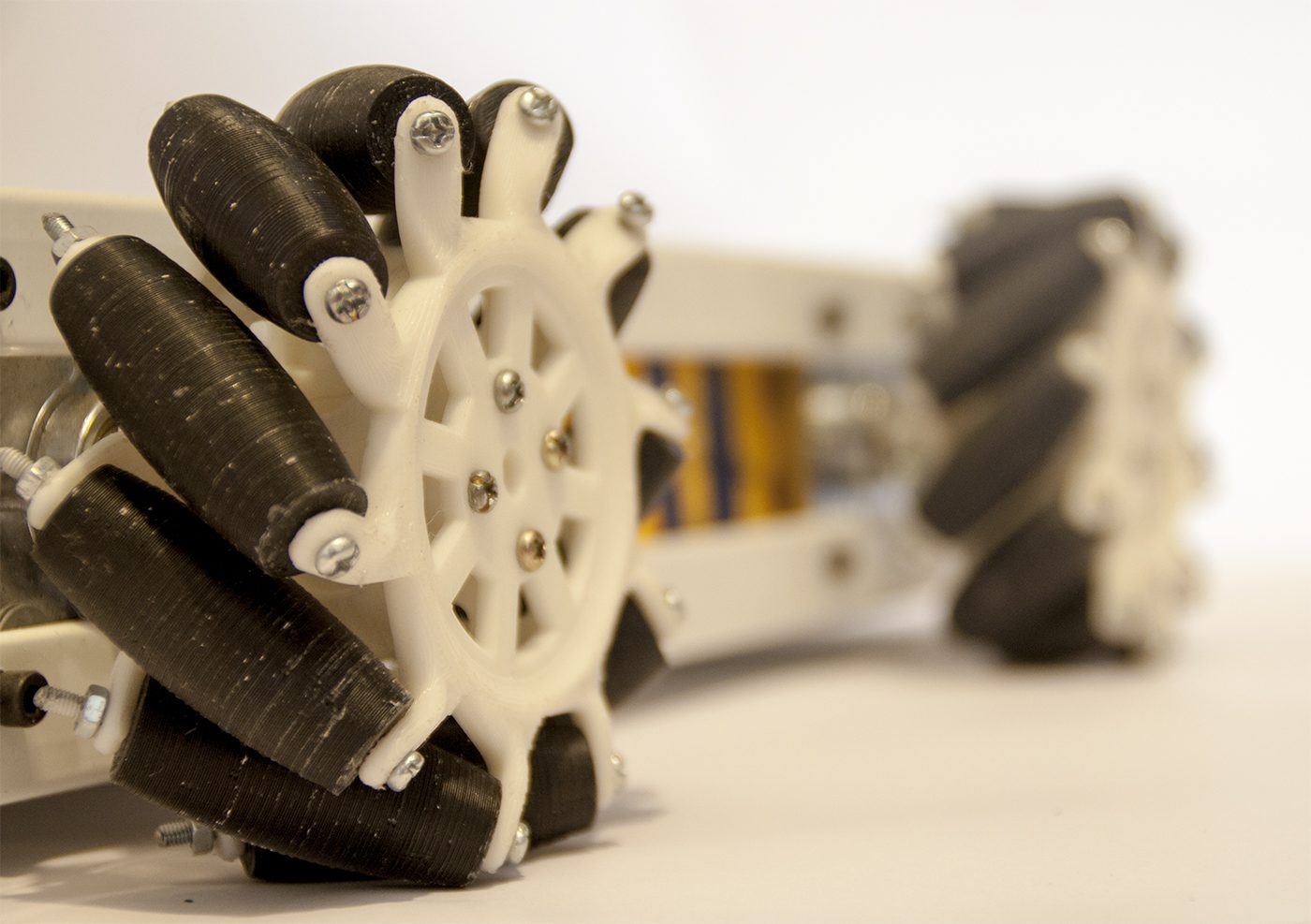Mechatronics, which is also called mechatronic engineering, is a multidisciplinary branch of engineering that focuses on the engineering of both electrical and mechanical systems, and also includes a combination of robotics, electronics, computer, telecommunications, systems, control, and product engineering.
Mechatronics Projects

Nail Pullout Resistance System
Cement products are one of the main materials used in construction projects. The production and consumption of cement products cause various environmental pollution, such as carbon dioxide production and water dissipation. According to the mechanical and chemical characteristics of geopolymer products, these materials have the potential to replace cement products. Geopolymer is the result of the polymerization reaction between an alkaline solution and a fine-grained aluminosilicate resource. Nailing is one of the most common soil slope stabilization methods. Portland cement is widely used in the construction of these systems. There are two main criteria for nailing grout in the FHWA soil nailing wall reference manual. Nailing grout should have sufficient flowability and compressive strength. On the other hand, the performance of the nailing system is mainly based on the nail pullout resistance.

Shaking Table Testing of Geo-technical Models
Shaking Table Testing of Geo-technical Models is an innovative project focused on developing a method for testing the response of geo-technical structures to earthquake-induced shaking. The project involves the use of a shaking table, which can simulate the effects of seismic activity on scaled-down models of geo-technical structures, such as dams, foundations, and retaining walls. The shaking table is equipped with advanced sensors and data acquisition systems to measure the response of the models to shaking, including their deformation, displacement, and stress distribution. The project aims to improve the understanding of the behavior of geo-technical structures during earthquakes, enabling engineers and designers to develop more effective and cost-efficient earthquake-resistant structures. The project highlights the potential of technology to improve safety in the construction industry, ultimately benefiting both workers and the general public. Overall, the Shaking Table Testing of Geo-technical Models project represents a powerful and innovative solution for improving the safety and reliability of geo-technical structures, and has the potential to revolutionize the field of earthquake engineering and design.
The findings of the Shaking Table Testing of Geo-technical Models project can be applied to real-world structures in several ways. Firstly, the project can help to improve the design and construction of geo-technical structures, including dams, foundations, and retaining walls, to make them more resistant to earthquake-induced shaking. The data acquired from the project can be used to develop more accurate and efficient models for predicting the behavior of these structures during seismic events, enabling engineers and designers to make more informed decisions about their design and construction.
Secondly, the project can inform the development of more effective retrofitting and rehabilitation strategies for existing structures, enabling them to better withstand earthquakes. The project’s findings can be used to identify areas of weakness in existing structures and develop retrofitting solutions that can improve their resilience to seismic events.
Thirdly, the project can help to improve the safety of communities that are at risk of earthquakes by informing the development of better building codes and regulations that promote the construction of more earthquake-resistant structures. The project’s findings can be used to inform policy decisions related to seismic safety and disaster risk reduction, ultimately benefiting society as a whole.
Overall, the Shaking Table Testing of Geo-technical Models project has the potential to significantly improve the safety and reliability of geo-technical structures in the face of seismic events, ultimately benefiting communities and individuals who rely on these structures for their safety and well-being.

Screw Anchor Testing Device
The Screw Anchor Testing Device project is an innovative initiative focused on developing a device for testing the strength and stability of screw anchors used in construction and engineering projects. The project involves the use of advanced sensors and control systems to apply a precise load to the screw anchor and measure its reaction under various conditions. The device is designed to be highly efficient and accurate, providing engineers and construction professionals with a powerful tool for testing the performance of screw anchors and ensuring their safety and reliability. Additionally, the project aims to improve the quality and durability of construction projects, by providing a means of testing and verifying the strength and stability of key structural components. The project highlights the potential of technology to improve safety and quality in the construction industry, ultimately benefiting both workers and the general public. Overall, the Screw Anchor Testing Device project represents a powerful and innovative solution for improving the efficiency and safety of construction and engineering projects and has the potential to revolutionize the field of structural testing and analysis.
The Screw Anchor Testing Device has several specific features that make it a powerful and effective tool for testing the strength and stability of screw anchors. These features include:
- Advanced sensors and control systems: The device is equipped with advanced sensors and control systems that allow for precise measurement and control of the load applied to the screw anchor during testing.
- Customizable load levels: The device can apply a range of load levels to the screw anchor, allowing for testing under a variety of conditions and scenarios.
- Real-time data analysis: The device provides real-time data analysis of the screw anchor’s response to the applied load, allowing for immediate feedback and adjustment of testing parameters.
- Portable design: The device is designed to be portable and easy to set up, making it ideal for use in the field or on construction sites.
- Efficient testing process: The device is designed to be highly efficient, allowing for rapid and accurate testing of multiple screw anchors in a short amount of time.
Overall, the Screw Anchor Testing Device’s advanced sensors and control systems, customizable load levels, real-time data analysis, portable design, and efficient testing process make it a powerful and effective tool for testing the strength and stability of screw anchors in construction and engineering projects.

Keeping and Removing Goods by the Warehouse Robot
At first, the goods with different colors and expiration dates are in front of the robot, and the robot must examine each of these goods and store them in its memory. The robot must prepare a list containing information about the goods (shape, color, expiration date) and arrange the list in the order of expiration date and display it on the display of the operator’s room. The robot must then enter the warehouse room and inspect the goods in the warehouse. There are some goods in stock that some of these goods can be identical in terms of characteristics, and some of these goods are the same as the goods that were originally listed; With the difference that the QR Code is not pasted on the goods inside the room and as a result, the expiration date of the goods is not directly visible; Therefore, the robot must find out the expiration date of the goods by relying on the characteristics of other goods (color and shape) and referring to the list prepared in the first step. Then select one of the items in the list prepared in the first step, which has an expiration date closer to expiration, identify all available items of that type in the room, and be ready to leave the storage cycle; Finally, the robot must display the result on the operator’s room display after leaving the room completely and stopping behind the mentioned frame.

Control and Monitoring Wireless Alcohol Tank Height Level System
The Control and Monitoring Wireless Alcohol Tank Height Level System project is an innovative initiative focused on developing a wireless system for monitoring and controlling the height level of alcohol tanks in industrial settings. The project involves the use of advanced sensors and control systems to measure and regulate the level of alcohol in the tanks, ensuring optimal conditions for production and storage. The system is designed to be highly efficient and cost-effective, with the ability to monitor multiple tanks simultaneously and provide real-time data analysis for informed decision-making. Additionally, the project aims to improve safety in the workplace by reducing the risk of spills and other accidents associated with overfilling or underfilling of tanks. The project highlights the potential of technology to improve industrial processes and promote sustainability, ultimately benefiting both businesses and the environment. Overall, the Control and Monitoring Wireless Alcohol Tank Height Level System project represents a powerful and innovative solution for improving the efficiency, safety, and sustainability of alcohol production and storage, and has the potential to revolutionize the field of industrial automation and control.
There are several benefits of using wireless sensors in the Control and Monitoring Wireless Alcohol Tank Height Level System.
Firstly, wireless sensors eliminate the need for complex wiring and infrastructure, making the system more adaptable and cost-effective. This allows for easier installation and maintenance of the system, reducing the overall operational costs.
Secondly, wireless sensors provide greater flexibility and mobility, allowing for real-time monitoring of multiple tanks from a central location. This enables operators to quickly respond to changes in tank levels and make informed decisions for optimal production and storage.
Thirdly, wireless sensors provide more accurate and reliable data, as they are not subject to interference or disruption from physical wiring. This increases the accuracy and reliability of the system, reducing the risk of errors or equipment failure.
Finally, wireless sensors promote sustainability by reducing the use of resources such as energy and materials and minimizing waste associated with traditional wiring methods. This makes the system more environmentally friendly and aligns with the growing trend toward sustainability in the industry.
Overall, the use of wireless sensors in the Control and Monitoring Wireless Alcohol Tank Height Level System offers numerous benefits, including cost-effectiveness, flexibility, accuracy, reliability, and sustainability, making it a powerful and innovative solution for improving the efficiency and safety of alcohol production and storage.

Fully Automated Bottle Filling and Labeling Production Line
The Fully Automated Bottle Filling and Labeling Production Line project is an innovative initiative focused on developing a state-of-the-art production line for filling and labeling bottles in industrial settings. The project involves the use of advanced sensors and control systems to efficiently fill and label bottles with high accuracy and speed. The production line is designed to be fully automated, with the ability to control all aspects of the production process, from filling to labeling, and packaging. Additionally, the project aims to improve the efficiency and productivity of bottle production operations, by reducing the need for manual labor and increasing the output rate. The project highlights the potential of technology to improve manufacturing processes and promote sustainability, ultimately benefiting both businesses and consumers. Overall, the Fully Automated Bottle Filling and Labeling Production Line project represents a powerful and innovative solution for improving the efficiency and quality of bottle production, and has the potential to revolutionize the field of manufacturing and production.
The Fully Automated Bottle Filling and Labeling Production Line project offers several potential environmental benefits. One of the main benefits is the reduction of waste associated with bottle production. By increasing the accuracy and efficiency of the production process, the project can reduce the amount of material wasted during production, and minimize the need for rework or defective products. Additionally, the project can help to reduce the carbon footprint associated with bottle production, by minimizing the use of energy and resources such as water, electricity, and packaging materials. The project can also contribute to reducing greenhouse gas emissions associated with transportation, by producing bottles closer to the point of consumption, reducing the need for long-distance shipping. Finally, the project can help to promote sustainable practices in the manufacturing industry, by reducing the environmental impact of bottle production and promoting the use of environmentally friendly materials and practices. Overall, the Fully Automated Bottle Filling and Labeling Production Line project represents a powerful and innovative solution for improving the sustainability of bottle production, and has the potential to contribute to a more environmentally conscious manufacturing industry.

Wireless Ambient temperature and humidity controller for drug storage and drug production hall
The Wireless Ambient Temperature and humidity controller for drug storage and drug production hall project is an innovative initiative focused on developing a wireless system for monitoring and controlling temperature and humidity levels in drug storage and production facilities. The project involves the use of advanced sensors and control systems to measure and regulate the ambient temperature and humidity levels, ensuring optimal conditions for drug storage and production. The system is designed to be highly efficient and cost-effective, with the ability to monitor multiple locations simultaneously and provide real-time data analysis for informed decision-making. Additionally, the project aims to improve safety and quality in drug production and storage, by reducing the risk of degradation or contamination associated with improper temperature and humidity levels. The project highlights the potential of technology to improve pharmaceutical manufacturing and storage practices, ultimately benefiting both the pharmaceutical industry and patients who rely on safe and effective medications. Overall, the Wireless Ambient temperature and humidity controller for drug storage and drug production hall project represents a powerful and innovative solution for improving the efficiency, safety, and quality of drug production and storage, and has the potential to revolutionize the field of pharmaceutical manufacturing and regulation.
There are several benefits of using the Wireless Ambient temperature and humidity control system for drug storage and production:
- Improved product quality: The system ensures that drugs are stored and produced in optimal conditions, reducing the risk of degradation or contamination and improving product quality.
- Increased efficiency: The system allows for real-time monitoring and control of temperature and humidity levels, reducing the need for manual monitoring and intervention, and increasing efficiency.
- Cost-effective: The wireless system eliminates the need for complex wiring and infrastructure, reducing installation and maintenance costs.
- Compliance with regulations: The system helps pharmaceutical companies comply with regulations related to drug storage and production, reducing the risk of non-compliance penalties.
- Promotes safety: The system helps to ensure that drugs are stored and produced in safe conditions, reducing the risk of accidents or errors caused by improper temperature and humidity levels.
- Data analytics: The system provides real-time data analysis and reporting, allowing for informed decision-making and continuous improvement of drug storage and production processes.
Overall, the Wireless Ambient temperature and humidity control system for drug storage and drug production hall offers numerous benefits, including improved product quality, increased efficiency, cost-effectiveness, compliance with regulations, promoting safety, and data analytics, making it a powerful and innovative solution for improving the efficiency, safety, and quality of drug production and storage.

